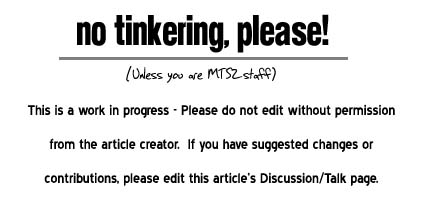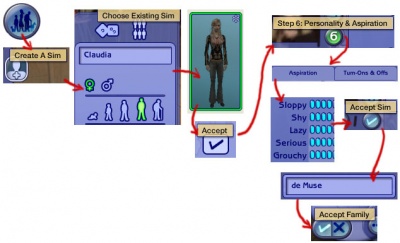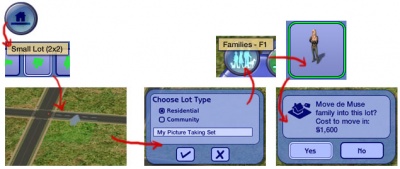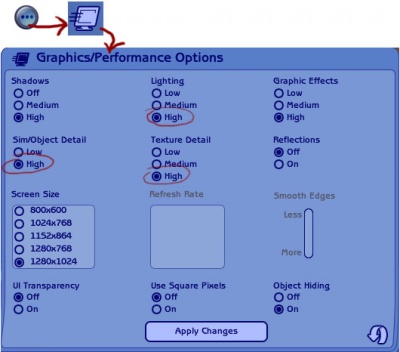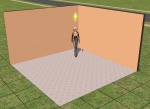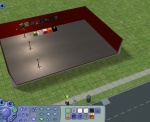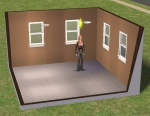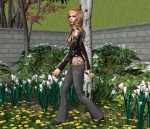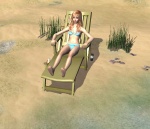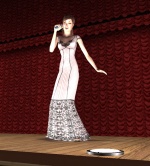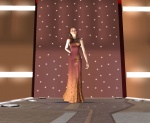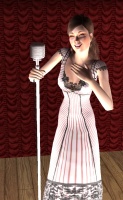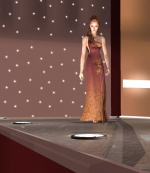Difference between revisions of "Tutorials:Taking Totally Bitchin Pics"
(→Composition) |
|||
| (2 intermediate revisions by one user not shown) | |||
| Line 154: | Line 154: | ||
[[Image:Bitchinpics-17.jpg|right|150x200px]]The most basic type of set is just two walls with flooring stretched between them. This will give you nice, brightly-lit pictures, and is perfect for getting a picture of a sim taken against a solid-colour background, often a requirement for contests. A plain background, with good lighting. Yup, that's about it. Or is it a little more complex than that? <br style="clear:both" /> | [[Image:Bitchinpics-17.jpg|right|150x200px]]The most basic type of set is just two walls with flooring stretched between them. This will give you nice, brightly-lit pictures, and is perfect for getting a picture of a sim taken against a solid-colour background, often a requirement for contests. A plain background, with good lighting. Yup, that's about it. Or is it a little more complex than that? <br style="clear:both" /> | ||
| + | |||
| + | ===[[Tutorials:Taking Totally Bitchin Pics/Quick Set|Quick Set]]=== | ||
| + | |||
| + | [[Image:Quickset4.jpg|right|150x200px]]After you've checked out the above information on how to set up a basic set, here's the steps I take when I'm getting ready to take many of my sim pics. | ||
| + | <br style="clear:both" /> | ||
===[[Tutorials:Taking Totally Bitchin Pics/Indoor Set|Indoor Set]]=== | ===[[Tutorials:Taking Totally Bitchin Pics/Indoor Set|Indoor Set]]=== | ||
| Line 221: | Line 226: | ||
How you manipulate the three elements depends on the final effect you wish to have. | How you manipulate the three elements depends on the final effect you wish to have. | ||
| − | |||
* An image with a blank background, subject in foreground, and no midground will focus the viewer strongly and firmly on your subject. | * An image with a blank background, subject in foreground, and no midground will focus the viewer strongly and firmly on your subject. | ||
| − | |||
* An image with a scenic background and subject in midground can make the viewer feel "closer" to the subject - you're along with the subject in their own environment, with nothing between the viewer and subject. | * An image with a scenic background and subject in midground can make the viewer feel "closer" to the subject - you're along with the subject in their own environment, with nothing between the viewer and subject. | ||
| − | |||
* An image with a scenic background and foreground, with your subject in midground separates the viewer from the subject. | * An image with a scenic background and foreground, with your subject in midground separates the viewer from the subject. | ||
| Line 237: | Line 239: | ||
When choosing your angle, you must consider how you want your viewer to relate to your subject. | When choosing your angle, you must consider how you want your viewer to relate to your subject. | ||
| − | |||
| − | |||
* '''From Above, Looking Down:''' An angle from above, looking down upon your subject, raises the viewer above the subject. Your sim is caught beneath the viewer's microscope and vulnerable. Angles from above are especially useful when your subject is portraying a negative emotion like sadness, helpless anger, or fear. It can also work well for expressions of exaltation or hope. | * '''From Above, Looking Down:''' An angle from above, looking down upon your subject, raises the viewer above the subject. Your sim is caught beneath the viewer's microscope and vulnerable. Angles from above are especially useful when your subject is portraying a negative emotion like sadness, helpless anger, or fear. It can also work well for expressions of exaltation or hope. | ||
| − | |||
* '''Level:''' Taking pics on the same level as your subject puts the viewer on equal footing. It can help make your viewer feel as if they are in the scene, and provides a greater sense of intimacy. Try to position your camera at the same height as your sim subject. If you press W to move the camera forward, you should not run into the sim's face or hair, but their upper chest below the hollow at the center of their collarbone. | * '''Level:''' Taking pics on the same level as your subject puts the viewer on equal footing. It can help make your viewer feel as if they are in the scene, and provides a greater sense of intimacy. Try to position your camera at the same height as your sim subject. If you press W to move the camera forward, you should not run into the sim's face or hair, but their upper chest below the hollow at the center of their collarbone. | ||
| − | |||
* '''From Below, Looking Up:''' Taking pics from below your subject puts your viewer in an inferior position to the subject. This is excellent if you want to portray a sense of power - place the camera as if you are kneeling before the subject. For portraying movie stars, divas, kings, etc., placing the camera just a bit below your sim can make your character seem larger than life. When you press W to move forward, you should run into the bottom of the sim's chest, at the bottom of their ribcage. | * '''From Below, Looking Up:''' Taking pics from below your subject puts your viewer in an inferior position to the subject. This is excellent if you want to portray a sense of power - place the camera as if you are kneeling before the subject. For portraying movie stars, divas, kings, etc., placing the camera just a bit below your sim can make your character seem larger than life. When you press W to move forward, you should run into the bottom of the sim's chest, at the bottom of their ribcage. | ||
| − | |||
Even more extreme angles from below can create quite dramatic pics, especially if you zoom out just a bit. To portray, for example, a child's fear of an angry parent, it can be much more effective to take a pic from extremely low, maybe behind a chair or under a table, zoomed out to make the room seem larger, looking up at the looming parent, than to look down on the frightened child themselves. | Even more extreme angles from below can create quite dramatic pics, especially if you zoom out just a bit. To portray, for example, a child's fear of an angry parent, it can be much more effective to take a pic from extremely low, maybe behind a chair or under a table, zoomed out to make the room seem larger, looking up at the looming parent, than to look down on the frightened child themselves. | ||
| Line 260: | Line 257: | ||
Symmetrical pics are highly intimate - the viewer's eye has nowhere to escape to, confronted immediately by your subject. Therefore, symmetrical pics are extremely effective at portraying heightened emotion - the sorrow, joy, or anger in your subject's eyes will be the focus of your pic. | Symmetrical pics are highly intimate - the viewer's eye has nowhere to escape to, confronted immediately by your subject. Therefore, symmetrical pics are extremely effective at portraying heightened emotion - the sorrow, joy, or anger in your subject's eyes will be the focus of your pic. | ||
| − | However, symmetry is extremely static. There is no movement beyond the center. Therefore, it should be used | + | However, symmetry is extremely static. There is no movement beyond the center. Therefore, it should be used sparingly, reserved for pics that need a certain stillness, rather than dynamic movement. |
====Asymmetry==== | ====Asymmetry==== | ||
| + | A picture that cannot be divided into two halves looking similar on both sides is symmetrical. Where symmetry is direct and static, asymmetry is indirect and dynamic. The eye will travel around the picture, lingering on details, before settling on your subject. | ||
| + | |||
| + | It creates a feeling of movement, activity, and drama, making your simple, non-animated pic seem to change as the eye shifts focus around the image. | ||
| + | |||
| + | You have to apply a bit more care and planning with asymmetrical pics, though. Because the eye travels through the pic, you have to take care to guide your viewer ultimately to your subject. | ||
| + | |||
| + | ====The Rule of Thirds==== | ||
| + | |||
| + | In guiding your viewers' eyes to your pic's subject, the Rule of Thirds can be extremely helpful. Imagine (or even actually draw) a set of lines across your pic, dividing it both vertically and horizontally into thirds, like a tic-tac-toe board. | ||
| + | |||
| + | If you're using Photoshop, do View - New Guide to set up a guideline. Set it to horizontal, 33%, then click OK. Repeat and do horizontal 66%, then vertical 33% and vertical 66%. You should now have your image divided into thirds by guidelines. | ||
| + | |||
| + | By placing your subject more toward these lines and where they intersect, rather than the center area, you can create a dynamic asymmetrical pic. | ||
| + | |||
| + | ====Leading Lines==== | ||
| + | |||
| + | Take a look at your pic and try to identify the main edges and lines in its forms. Strong horizontal and vertical lines at right angles tend to create a feeling of solidity, rigidity, and formality. Diagonal, slanted lines are more dynamic, creating a sense of movement. While both right-angled and diagonal lines will guide the eye, diagonal lines pull the eye along better than right-angled ones. | ||
| + | |||
| + | The use of lines set up specifically to lead the eye to the subject can be particularly effective in creating a dynamic pic. One or more lines pointing toward the subject will draw the viewer's eye toward it. | ||
| + | |||
| + | If the focus of a pic is inanimate, or a second sim, a sim's line of sight can be a more subtle but creative way to draw your viewer's eye there, too. | ||
| + | |||
| + | ===Colour=== | ||
| + | |||
| + | While most applications will suggest a colours cheme, how exactly you use those colours, and their interplay with the rest of your pic, can have a big impact on the overall feel. | ||
| + | |||
| + | * '''Main Colour:''' Your main colour is either the predominant colour in your pic, or, if there are several colours and no one can be said to be the predominant colour, your main colour is an average of all the colours in your pic. In Photoshop, you can average colours with Filter - Blur - Average. Your main colour sets the overall tone and mood of the pic, so make sure you choose it well. | ||
| + | |||
| + | * '''Secondary Colour:''' This is the next most dominant colour in your pic. Generally this will be one colour but you may have more than one secondary colour. For a feeling of harmony and unity through the pic, keep your secondary colours coordinating with the main colour. For more "pop" go for a colour that's wildly different than your main colour. | ||
| + | |||
| + | * '''Accent Colours:''' These are colours that appear in very small amounts in your pic, but are extremely important for the overall look. Often the colour of a sim's eyes can be your accent colour... or a shade in their makeup, streaks in their hair, or jewelry. Having an accent colour that is quite different from your main and secondary colours will make it stand out, and draw the eye to that colour. | ||
| + | |||
| + | ====Choosing Colour Schemes==== | ||
| + | |||
| + | (Eyedroppering colours from pretty pics) | ||
| + | |||
| + | ====Tone==== | ||
| + | ====Contrast==== | ||
===Lighting=== | ===Lighting=== | ||
Latest revision as of 18:48, 27 April 2007
Contents |
[edit] Taking Totally Bitchin' Pics
This long and verbose tutorial will give you tons of info on making your pics for your creations and contests much better. This tutorial is mostly focused on sims and taking pics of them and their content, but the tips here will be useful for many applications.
[edit] Introduction
Okay, so, your pics suck. No, they do, really, just admit it. It's okay. Admitting it is the first step. Breathe deep and just let it out. There, there, it's all right. We'll get you fixed up.
Yes, this tutorial is long, and has many sections, but if you go through everything in order, read everything, and wrap your mind around it, you are guaranteed to no longer suck.
The game's engine is capable of taking some awesome pics, but you really have to know what you're doing in order to make use of it.
[edit] You Will Need
- The Sims 2, duh.
- A decent enough graphics card that you can turn up Sim/Object Detail, Lighting, and Texture Detail to High. You do not need smooth edges, reflections, or any other fancy doodadery. I don't even have a graphics card, let alone a good one, just some patience with slow framerates.
- A graphics editing program. The better the program the more you will likely be able to do with filters, etc. to improve your pics. I recommend Photoshop - though the current versions are several hundred dollars, you can purchase a used copy of Photoshop 7 for around $40 on eBay and get most of the same functions. You can also use Paint Shop Pro, Corel Photo Paint, Paint.NET, and GIMP, the last two of which are free. You can likely use most any other program that is capable of a few filters like Brightness/Contrast and Levels, some blurs, and multiple layers.
This tutorial will be written showing techniques from Photoshop, specifically Photoshop CS2. If you have earlier versions of Photoshop, or if you are using a different program, you may not be able to do everything here, or you may not be able to do things exactly as they are stated here with the same tools - most programs will offer alternate methods to do just about anything, but it's up to you to know your graphics editing program and know it well. This is NOT a tutorial for people who have just stopped playing in Microsoft Paint, so if you're unclear on your program, go Google "beginner (program name) tutorial".
[edit] Hacks and Poses
There are several important modifications you need to make to your game before you continue, if you want to take truly awesome pictures.
- GunMod's Camera Hack will give you MUCH better control of the camera in Cameraman mode, and allow angles and shots you could never achieve with the limits on the default camera.
- Radiance Lighting 2.2 will change the way the game's lighting works, to make for much more realistic, dramatic lighting effects. You can probably use Radiance Lighting even if you have a crappy graphics card. You will likely have to fundamentally change the way you use lighting once you install it, though, and you'll often find yourself using more lights to get things well lit. For more on using lights under Radiance Lighting, see the information in the tutorial on lighting your scene.
- The InSIMenator - While the InSIM won't directly give you more interesting or better pics, its myriad functions to tweak gameplay are endlessly useful.
Those above are pretty much essential, but if you're taking pictures of sims and you want some really great poses, you're going to need some hacks or hacked objects that allow you to put your sim in a variety of poses on demand. For that, you'll want to see the list at Content List: Hacks and Hacked Objects: Pictures, Movies, Stories, and Poses. Specific items listed there and ways to utilize them will be gone over in the rest of the tutorial.
[edit] Windowed Mode
In order to take your pictures using the methods described here, you will need your game running in a window, so you can easily switch to other applications without causing major instability and lag. Instructions on setting up Windowed Mode may be found here.
Windowed mode should be perfectly safe - in fact, some users actually report better game performance when running in a window. Your mileage may vary.
[edit] No more C Key
In order to take truly bitchin' pics, you should not use the game's screenshot system, using the C key or the camera button on the game's controls to take your pictures. Even on the highest picture settings, pictures will still be small, with a very high level of JPEG compression, making them blurry and crunchy. Small, blurry, and crunchy pics are in no way bitchin'.
[edit] Screenshot Program
There are many programs available, free and pay, that will take screenshots for you by using a hotkey, and save them to a folder - just like The Sims 2 with the C key, but with options for much better quality settings. There is a free version of FRAPS available that is a simple, quick, and easy program to use: http://www.fraps.com/
A quick Google search for 'free screenshot program' will also bring up many other options, which may have other features that are of interest to you.
[edit] Print Screen
If you have enough RAM to run Photoshop or another graphics editing program at the same time as Sims 2, you may want to take screenshots yourself, without the use of a program to store them for you.
To do that, simply press the Print Screen or PrntScn key on your keyboard - it's usually off toward the right, over the arrow keys, above Insert and Delete. This will copy your current screen to your Windows clipboard, as if you had selected and copied it as an image.
Then open any graphics editing program, create a new document the size of your monitor's resolution, and paste into that document. Your screenshot should appear in the document.
[edit] Make Your Sim
Sims look best on a lot, so we're going to create a sim and put it on a blank lot to take pics. This will make an extra character file just to take pics, so if you have a big, overcrowded Legacy neighborhood, you might want to create a blank neighborhood for pics and testing to keep this out of your main 'hood.
Otherwise, go into Create a Family/Create a Sim and to in to create a sim. Enter a first name, and make sure you have it set to the right age and gender. Then click on the Choose Existing Sim button. Find your sim in the sim bin and click Accept. Jump to 6, where you set your sim's personality and aspiration. Choose an aspiration for your sim, and set their personality points. To avoid slouchy, gross sims, make sure they have at least 3 points in Sloppy and Lazy. Setting it to Aquarius gives you a basic personality. If you have Nightlife give your sim some Turn-Ons and a Turn-Off. Then choose Accept Sim. At the family screen, type a family name, and then click Accept Family.
[edit] Create a Set
Now you'll be back in your neighborhood. It's time to create an empty lot that you can use as a picture-taking set for your sim.
Click on the Lots and Housing button, then choose an empty lot. 2x2 is a good size. Place the lot in a blank spot in your neighborhood, and give it a name. It should be a Residential lot. Click on the Families button and find the sim you just made in the sim bin. Click on the empty lot you just created and move them into it.
[edit] Game Options
[edit] Graphics Settings
When you have gotten the lot fully loaded, you will want to first make sure your graphics options are turned up. Click on Options - Graphics/Performance Options.You will need Lighting, Sim/Object Detail, and Texture Detail at least turned up to High. Shadows can also help your pictures look more realistic, depending on how nice a graphics card you have. When you have turned your settings up, click Apply Changes.
It may take several minutes for the game to begin responding again. You will get a dialogue asking if you want to save your changes with a countdown of 15 seconds. Click yes within those 15 seconds to keep your new settings - if you miss seeing that window, your options will revert to their previous levels, and it may seem like nothing happened.
[edit] Free Will
Now we need to make sure our sim is not going to go running off to read the paper while we're trying to take pictures. Click on Options - Game Options and turn OFF Free Will.
[edit] Camera Controls
Take some time to just play around with the camera, especially if you have just installed the camera hack. It can take a while to get used to the camera controls, and even once you are experienced in their use, it may be challenging to get the shot you want with the constraints on the controls.
If you haven't taken many sim pictures before, here is a list of camera controls:
- TAB
Puts the game into Cameraman mode, allowing better and more control of the camera. Make sure you are in live mode before going into Cameraman mode or you will see grid lines on the ground and floating where floor tiles may be placed.
- W and S
W moves the camera forward. S moves it backward.
- A and D
A moves the camera left. D moves it right.
- Q and E
Q lowers the camera. E raises it.
- + and -
Zooms in and out. The further you are zoomed in, the smaller the increment you will move when using the WASD keys if you have the camera hack as advised above.
[edit] Cheats
Remember, our focus here is not on playing the game by all the rules, but taking the absolute best pictures we can, so cheat like mad! Here are some cheats that you should definitely be familiar with, and how they may be of use to you for picture taking:
- moveObjects on - This will allow you to place more than one object on a tile, and pick up and move items that you cannot normally manipulate. Most importantly, this will allow you to pick up and move your sim by hand just as you would any object, rather than having to wait for them to walk somewhere, assuming there is even a complete route to where you want them. Please note that if you have this cheat set to on, windows and doors will not snap onto walls, especially diagonals - you will need to set it back to off for easy placement of doors and windows.
- boolProp snapObjectsToGrid [true/false] - With this cheat set to false, you'll be able to place objects exactly as you want them, without them snapping to the gridlines. This will allow much better placement of sims as well as objects, and can make for a much more natural, haphazard look to the placement of objects in your pictures. Please note that if you have this cheat set to false, your windows and doors will no longer place properly - you will need to set it back to true for them to snap into place.
- boolProp allow45DegreeAngleOfRotation [true/false] - Instead of just having the four cardinal directions to rotate sims and objects, with this cheat set to true, you'll be able to rotate objects in 45 degree increments, allowing you to place objects and sims diagonally. This is helpful for exact positioning of a sim facing the direction you want them, and again, will make for more natural looks to scenes. You will need to use the < and > (, and .) keys on your keyboard to rotate the objects - clicking and dragging will not work. You will need at least one expansion to use this cheat normally. However, because the coding for this cheat was actually included in the base game, you can use this hacked bamboo plant by wintermuteai1 at MTS2 to accomplish the same thing in the base game.
- plumbbobToggle [on/off] - Set to off to turn off the plumbbob (floating diamond) that denotes your active sim. You will need Open for Business or later expansions to use this cheat. If you do not have Open for Business or later expansions, you can use the No Balloons Patch by Inge Jones at SimLogical to remove the plumbbob, or make sure you crop it out of your photos.
- showHeadlines [on/off] - Set to off to turn off thought bubbles, speech bubbles, and relationship gain/loss (++/-- graphics) over sims' heads. Making sure these graphics and the plumbbob are off (or cropped out of your pics) will make for a much more realistic look. You will need the Nightlife expansion or later for this cheat to work. If you do not have Nightlife or later expansions, you can use the No Balloons Patch by Inge Jones at SimLogical to remove these graphics.
- slowMotion [0-8] - Allows you to slow down the game's speed. Acceptable values are 0-8, 0 being normal game speed, and 8 being the slowest. Generally slowMotion 4 is about the right speed to use for picture taking, as it allows you to pause on exactly the right facial expression and pose for the perfect picture.
- maxMotives - Maxes all the needs and motives (hunger, bladder, etc.) of every sim on the lot. Very useful for keeping sims from wetting themselves while you're trying to get them to pose. You will need Nightlife or later expansions to use this cheat.
- motiveDecay [on/off] - Set to off to stop the slow reduction of sim needs and motives over time. Helpful in combination with maxMotives for long picture-taking sessions. You will need Nightlife or later expansions to use this cheat.
- aspirationLevel [0-5] - Set the sim's aspiration to the selected level. 0 is aspiration failure, 5 is platinum. Useful to keep your sims from going nuts and having a visit from the psychiatrist while you're trying to take pics. You will need Nightlife or later expansions to use this cheat.
- lockAspiration [on/off] - Set to on to keep a sim's aspiration from slowly lowering over time. Use in combination with aspirationLevel 5 to keep your sims happy and sane for long picture-taking sessions. You will need Nightlife or later expansions to use this cheat.
- setHour [0-23] - Allows you to set the hour of the day, so you can take nighttime shots with ease, or switch back to daytime if it gets dark in the middle of your shoot. You will need Open for Business or later expansions to use this cheat.
There is a full listing of all of the cheats with their expansion pack requirements and descriptions of their use available in the Game Help section at MTS2. There may be more cheats that you will find useful there as well.
If you would like to shorten some of the longer cheats for easier use (so you can just type "moo" instead of "moveObjects on" for instance), or put on certain cheats automatically, you can do so by setting yourself up a userstartup.cheat file. There is a tutorial on how to do that on MTS2 in the Game Help section.
[edit] Beginner Sets
These are the simplest of set types, but learning the basic concepts of setting up even a simple set will help you as you do more advanced sets.
[edit] Basic Set
The most basic type of set is just two walls with flooring stretched between them. This will give you nice, brightly-lit pictures, and is perfect for getting a picture of a sim taken against a solid-colour background, often a requirement for contests. A plain background, with good lighting. Yup, that's about it. Or is it a little more complex than that?[edit] Quick Set
After you've checked out the above information on how to set up a basic set, here's the steps I take when I'm getting ready to take many of my sim pics.
[edit] Indoor Set
Exterior lighting will give you bright lighting, but if you would like more depth to your pictures without bright, harsh daylight, you can add a few walls to the simple set, and create an interior set. It may be tempting to use an existing house for pictures, but generally building a small set just for pics is better, as you will be able to take pictures much quicker on a smaller lot with only your needed walls and objects.[edit] Advanced Sets
Instructions on creating more complicated sets, which are generally quite a bit more time consuming. Of course, these instructions just show the basics you will need to make these sets... you can always expand on the techniques and use different content for a variation on the theme. Again, it's recommended you read through all of these, as there are great tips in each one that you may be able to use for all kinds of other things, too.
[edit] Garden Set
How to set up a realistic, beautiful outdoor scene, for a very natural look.
[edit] Beach Set
For your hot sims on hot days, here's how to set up a realistic beach set.
[edit] Home Set
[edit] Loft or Industrial Set
[edit] Stage Set
To set up a stage for a play or musical performance, here's some simple instructions that will get you rockin' in time for the show.
[edit] Runway or Catwalk Set
Yes, yes, we all make VERY pretty pixel dolls, don't we? Well, if you've got some skinny little model in a ridiculous outfit and funky makeup that just HAS to strut down a runway, here's how to make a pretty one.
[edit] Posing Sims
[edit] Emotive Poses
Fantastic for stories or contests, this big list of emotive facial expressions and poses will help you get just the right emotion in pics.
[edit] Evil Poses
Devious deviant need to let their evil shine through? I won Queen of Evil. I got you covered.
[edit] Posing on Surfaces
[edit] Stage Performance or Singing
For your rock star, lounge singer, or hot little diva, here's how to get some great poses that really make it look like your sim is performing on stage.
[edit] Modeling Poses
It is NOT all about that damn flamingo, seriously. Learn some creative ways to create elegant models in interesting poses.[edit] Details
[edit] Framing a Scene
[edit] Composition
Anyone can snap a picture of a sim, and, assuming you've followed the tutorial up to this point, it will look nice... But there is an additional level of complexity: the interplay of shape and form within an individual image, which, if properly constructed, can add to the emotion, drama, and impact of the image.
To a degree, some of this is intuitive, and with enough practice, you will begin to just feel out a properly composed image, but these guidelines will get you started looking for the right elements to incorporate into your own work.
[edit] Foreground, Midground, and Background
Every picture potentially contains three basic "grounds" meaning the distance of the elements from the camera. These are foreground, midground, and background.
The background is generally the furthest point from the viewer. It can be the sky, walls, rolling hills, the ocean, etc. The background of your pic will set much of the tone, especially in color. The foreground is whatever is closest in the image. This may be the subject, or it may be something in front of the subject, like a row of plants. The midground (as you might guess) is between the foreground and the background, and may be more scenery, or may be your focal point.
How you manipulate the three elements depends on the final effect you wish to have.
- An image with a blank background, subject in foreground, and no midground will focus the viewer strongly and firmly on your subject.
- An image with a scenic background and subject in midground can make the viewer feel "closer" to the subject - you're along with the subject in their own environment, with nothing between the viewer and subject.
- An image with a scenic background and foreground, with your subject in midground separates the viewer from the subject.
[edit] Angle
This is an area that a lot of people taking sim pics seem to ignore, or don't understand.
As a player, you watch your sims from above most of the time, looking down at them over their shoulders. This is great for gameplay, to direct them to tasks, but this "God's Eye View" is less than perfect for most sim pictures.
When choosing your angle, you must consider how you want your viewer to relate to your subject.
- From Above, Looking Down: An angle from above, looking down upon your subject, raises the viewer above the subject. Your sim is caught beneath the viewer's microscope and vulnerable. Angles from above are especially useful when your subject is portraying a negative emotion like sadness, helpless anger, or fear. It can also work well for expressions of exaltation or hope.
- Level: Taking pics on the same level as your subject puts the viewer on equal footing. It can help make your viewer feel as if they are in the scene, and provides a greater sense of intimacy. Try to position your camera at the same height as your sim subject. If you press W to move the camera forward, you should not run into the sim's face or hair, but their upper chest below the hollow at the center of their collarbone.
- From Below, Looking Up: Taking pics from below your subject puts your viewer in an inferior position to the subject. This is excellent if you want to portray a sense of power - place the camera as if you are kneeling before the subject. For portraying movie stars, divas, kings, etc., placing the camera just a bit below your sim can make your character seem larger than life. When you press W to move forward, you should run into the bottom of the sim's chest, at the bottom of their ribcage.
Even more extreme angles from below can create quite dramatic pics, especially if you zoom out just a bit. To portray, for example, a child's fear of an angry parent, it can be much more effective to take a pic from extremely low, maybe behind a chair or under a table, zoomed out to make the room seem larger, looking up at the looming parent, than to look down on the frightened child themselves.
[edit] Balance and Flow
Though it can be tempting to just point and shoot, if you take care with the way you take and crop your pics, you can use certain aesthetic properties to guide the eye how you want it.
[edit] Symmetry
A picture that is essentially the same left and right, if divided down the center, is symmetrical. Symmetrical pics draw the eye immediately and directly to the center. There is no pause, no wandering of the eye toward the subject. Your picture is your subject and nothing else. Extra details outside your subject should be symmetrical (and essential) or eliminated.
Symmetrical pics are highly intimate - the viewer's eye has nowhere to escape to, confronted immediately by your subject. Therefore, symmetrical pics are extremely effective at portraying heightened emotion - the sorrow, joy, or anger in your subject's eyes will be the focus of your pic.
However, symmetry is extremely static. There is no movement beyond the center. Therefore, it should be used sparingly, reserved for pics that need a certain stillness, rather than dynamic movement.
[edit] Asymmetry
A picture that cannot be divided into two halves looking similar on both sides is symmetrical. Where symmetry is direct and static, asymmetry is indirect and dynamic. The eye will travel around the picture, lingering on details, before settling on your subject.
It creates a feeling of movement, activity, and drama, making your simple, non-animated pic seem to change as the eye shifts focus around the image.
You have to apply a bit more care and planning with asymmetrical pics, though. Because the eye travels through the pic, you have to take care to guide your viewer ultimately to your subject.
[edit] The Rule of Thirds
In guiding your viewers' eyes to your pic's subject, the Rule of Thirds can be extremely helpful. Imagine (or even actually draw) a set of lines across your pic, dividing it both vertically and horizontally into thirds, like a tic-tac-toe board.
If you're using Photoshop, do View - New Guide to set up a guideline. Set it to horizontal, 33%, then click OK. Repeat and do horizontal 66%, then vertical 33% and vertical 66%. You should now have your image divided into thirds by guidelines.
By placing your subject more toward these lines and where they intersect, rather than the center area, you can create a dynamic asymmetrical pic.
[edit] Leading Lines
Take a look at your pic and try to identify the main edges and lines in its forms. Strong horizontal and vertical lines at right angles tend to create a feeling of solidity, rigidity, and formality. Diagonal, slanted lines are more dynamic, creating a sense of movement. While both right-angled and diagonal lines will guide the eye, diagonal lines pull the eye along better than right-angled ones.
The use of lines set up specifically to lead the eye to the subject can be particularly effective in creating a dynamic pic. One or more lines pointing toward the subject will draw the viewer's eye toward it.
If the focus of a pic is inanimate, or a second sim, a sim's line of sight can be a more subtle but creative way to draw your viewer's eye there, too.
[edit] Colour
While most applications will suggest a colours cheme, how exactly you use those colours, and their interplay with the rest of your pic, can have a big impact on the overall feel.
- Main Colour: Your main colour is either the predominant colour in your pic, or, if there are several colours and no one can be said to be the predominant colour, your main colour is an average of all the colours in your pic. In Photoshop, you can average colours with Filter - Blur - Average. Your main colour sets the overall tone and mood of the pic, so make sure you choose it well.
- Secondary Colour: This is the next most dominant colour in your pic. Generally this will be one colour but you may have more than one secondary colour. For a feeling of harmony and unity through the pic, keep your secondary colours coordinating with the main colour. For more "pop" go for a colour that's wildly different than your main colour.
- Accent Colours: These are colours that appear in very small amounts in your pic, but are extremely important for the overall look. Often the colour of a sim's eyes can be your accent colour... or a shade in their makeup, streaks in their hair, or jewelry. Having an accent colour that is quite different from your main and secondary colours will make it stand out, and draw the eye to that colour.
[edit] Choosing Colour Schemes
(Eyedroppering colours from pretty pics)
